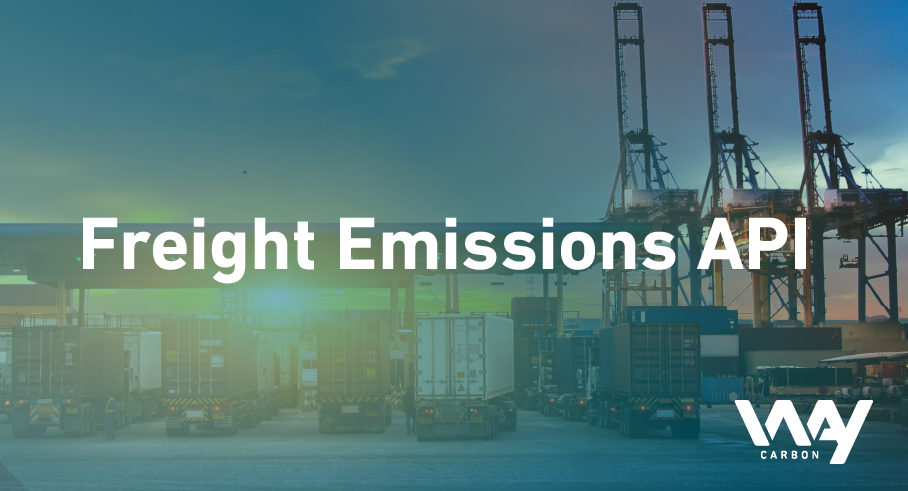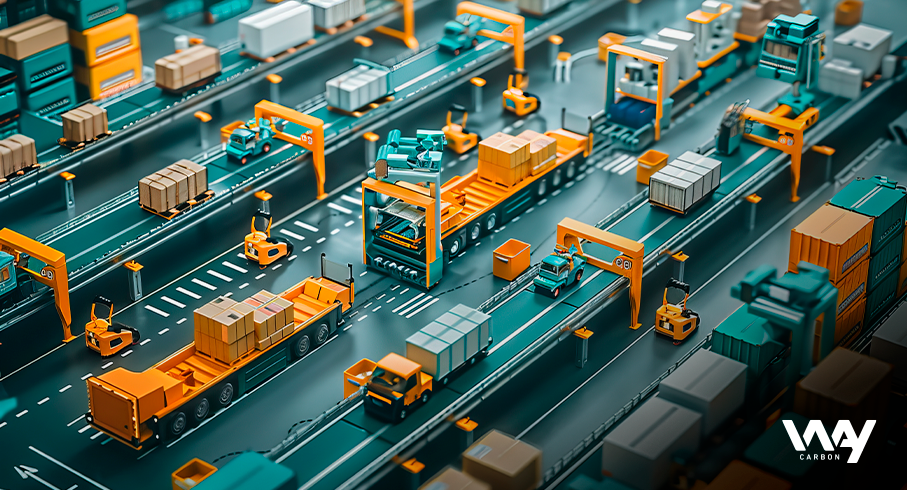WayCarbon launches API for calculating fleet GHG emissions
According to the Ministry of Science, Technology and Innovation, greenhouse gas (GHG) emissions from road transport in Brazil amounted to 123 MtCO2e in 2020, corresponding to 7.4% of national emissions. Half of these emissions refer to larger vehicles, such as trucks and buses.
In such context, the emissions calculation og logistics fleets and decarbonization in the transport sector are highly complex initiatives, which involve several actors in a value chain. Therefore, WayCarbon is launching a solution to assist companies in this challenge: the Feight Emissions API.
The challenges of calculating logistics GHG emissions
Industries, retailers, and several other types of companies have complex supply chains, both upstream – from suppliers to factories – and downstream – from factories to clients.
Logistics between all links in the supply chain involves own or outsourced transport and can depend on various types of modes – from heavy trucks in the upstream to light vehicles for the last mile in the downstream. Calculating the greenhouse gas emissions of this logistics can be quite challenging for a few reasons.
- Volume of transactions
Companies have large volumes of logistics transactions. Industrialized products with a complex supply chain and retailers with thousands of products available in hundreds of geographically dispersed stores are just two examples of businesses that demand a high volume of routes traveled daily.
- Own x outsourced fleet
When the logistics is performed by its own fleet, the company usually has controls that allow the calculation of the volume of GHG emissions, such as, for example, the consumption per type of fuel – or, at least, the amounts spent with fuel, so it can make an approximate consumption calculation per type of fuel.
However, in general, much of the logistics is outsourced to different suppliers, making the task of measuring logistics emissions more challenging. Carriers, for example, have information about the vehicle type and traveled route, which can be used to estimate fuel consumption, however, in general, this information is not provided to the contracting company.
- Changes in emission factors
In addition to measuring fuel consumption, it is necessary to transform them into emissions of different types of gases (CO2, CH4, N2O) and subsequently convert them to tCO2e. These factors, however, change over time, depending, for example, on the increase or reduction in biodiesel use in diesel. This effect means that emissions from the same stretch may have variations in emissions volume in two different periods.
The Freight Emissions API Solution
The Freight Emissions API purpose is to support companies in calculating their greenhouse gas emissions of logistics. The solution is initially available for calculating road transport in Latin America.
APIs are used for integration between systems, providing flexibility for creating different types of applications. Some applications examples are mentioned below.
- Improvement in the calculation of scope 1 and 3 emissions
Companies that have emission reduction targets must consider their total GHG emissions, including emissions from their own fleet and supply chain.
The API can simplify this task, as the company can send whatever information formats it has available, be it fuel consumption, the total amount spent on fuel or even detailed information for each stretch, such as type of truck, zip code of origin and destination and goods’ weight. The greater the accuracy of the information sent, the greater the precision in calculating the volume of GHG emissions.
- Freight routing
Num país onde o principal modal de transporte é o rodoviário, frequentemente o custo do frete é componente relevante para as margens financeiras dos negócios que envolvem distribuição de produtos. Assim, o tema de roteirização do frete tende a levar em consideração diferentes variáveis – não apenas a distância, como também questões tributárias e de segurança. Com o uso da API, as emissões de GEE podem não apenas ser conhecidas, como também precificadas, passando a incorporar a inteligência de decisão da roteirização final.
- Neutral freight
Freight neutralization should always be understood as a complementary strategy to other mitigation initiatives that the company already has in place. Simply offsetting emissions – or, in other words, purchasing carbon credits in volumes equivalent to the emissions – without other reduction measures – is an inappropriate practice that may expose the company to questioning. Thus, carriers that want to offer neutral freight to their customers or companies with their own logistics that offset their emissions need to ensure that they are acting in line with the best practices advocated by scientists and climate change experts.
Relevance to companies’ decarbonization strategy
The stimuli for the transport sector decarbonization go through technological changes. Changes in the fleets’ composition – with a greater tendency towards the electric vehicles adoption, for example – need to be reflected in data, not only for internal management, but also in the form of external reports that communicate the results obtained from these initiatives and investments. In this sense, the FREIGHT EMISSIONS API allows the emissions calculation of the current fleet, so it can be compared to the projected reductions from the adoption of these new technologies or with the effective reductions after their adoption.
The FREIGHT EMISSIONS API hits the market to provide the possibility of generating innovative products and services in the logistics area, as well as to allow companies to create management and reporting mechanisms for their logistics decarbonization initiatives. Contact WayCarbon’s experts and learn more.
Bibliographic references
MCIT. Estimativas Anuais de Emissões de Gases de Efeito Estufa no Brasil – 6th edition. 2022. Available at https://www.gov.br/mcti/pt-br/acompanhe-o-mcti/sirene/publicacoes/estimativas-anuais-de-emissoes-gee.
MCTI. Dados digitais sobre transporte no Brasil podem auxiliar na elaboração do Inventário Nacional de gases de efeito estufa. Available at: https://www.gov.br/mcti/pt-br/acompanhe-o-mcti/noticias/2021/06/dados-digitais-sobre-transporte-no-brasil-podem-auxiliar-na-elaboracao-do-inventario-nacional-de-gases-de-efeito-estufa







